
| Home |
Contents | Downloads | Resources |
Chapter 3: The Fur Trade
Page 18: The Hartney – Lauder Posts
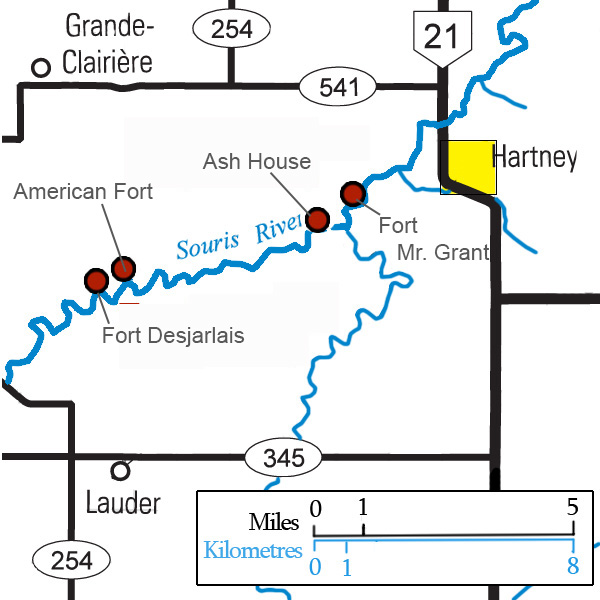 The fur trade in Manitoba began with the establishment of the Hudson’s Bay Company in 1670, and for nearly a century Aboriginal traders made the long trip to the shores of Hudson’s Bay to exchange furs for European trade goods shipped in from Britain. In the 1870’s independent traders, and the Northwest Company from Montreal, started to trade in what used to be HBC territory. The HBC had to move out from Hudson’s Bay to compete. For a time, Souris Mouth, where the Souris River empties into the Assiniboine, was an important centre with up to five trading posts operating within a few kilometres. Starting in 1795, traders were building trading posts farther west, along the Souris River. Between Hartney and Lauder, four important posts have been identified. These posts were along the river and close to the grazing grounds of the buffalo. The production and supply of pemmican, was a big part of their business. Fort Ash (Fort de la Freniere) The first fur post established on the river was Fort Ash. Canadian explorer David Thompson spent about two days in the region in December of 1797, on his way south to Mandan country. He recalled passing by “the old trading post called the Ash House from the plenty of those fine trees. It had to be given up from it being too open to the incursions of the Sioux." The American Fort On the north bank of the Souris, almost straight north of Lauder, is a site locals referred to as the American Fort, likely built by the American Fur Company in about 1810. The size of its chimney mounds indicates that it was in operation for some time, but few records have been found to tell us more. Fort Mr. Grant In 1824 Cuthbert Grant built Fort Grant on the Souris River, about two miles south west of Hartney. He was encouraged in this venture by HBC boss, Governor Simpson, who expected Grant to keep American and independent traders out of the Souris Valley. It is on the north bank of the river, perhaps fifty yards from the water. The cellars and chimney mounds were still visible in 1948. Fort Grant operated from 1824-1861, part of this time as a winter fort only. |
Page 19: Fort Desjarlais
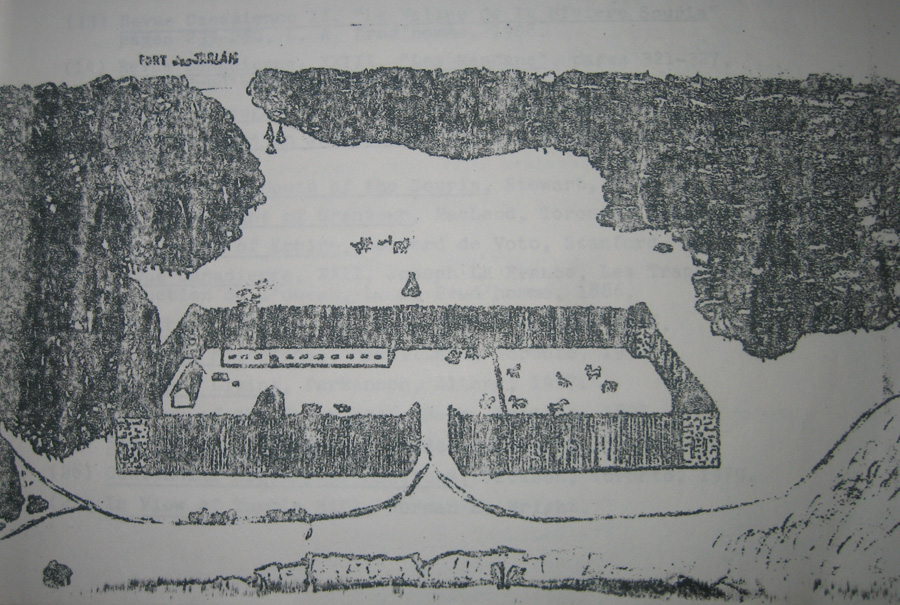
A sketch from the “Souris Valley Plains” by Hartney teacher and historian Larry Clarke.
| Fort
Desjarlais, built in 1836 by Joseph
Desjarlais, was located on the
north bank of the Souris, north of Lauder and very close to the
American Fort. It featured a sturdy oak palisade surrounding a long log building and several smaller ones. The Souris River ran past the south wall. As the site was in the territory frequented by Dakota war parties it was well protected. At its peak there would often be over seventy men at the fort. It operated for about twenty years, and was likely destroyed in the great prairie fire that swept the region in 1856. The fort was serviced mainly by Red River carts using the Yellow Quill Trail, which ran from near Fort Garry (Winnipeg), up the Assiniboine and Souris Rivers. It is believed that Desjarlais and his men were also buffalo hunters - trading buffalo robes and selling pemmican to the Hudson Bay Company. A Changing Economy Around 1850 the fur trade was becoming a less important part of the economy of our country. By 1874 the boundary between Canada and the United States was marked and both countries began surveying the land and dividing it into the section-township-range system – for use as farms. |
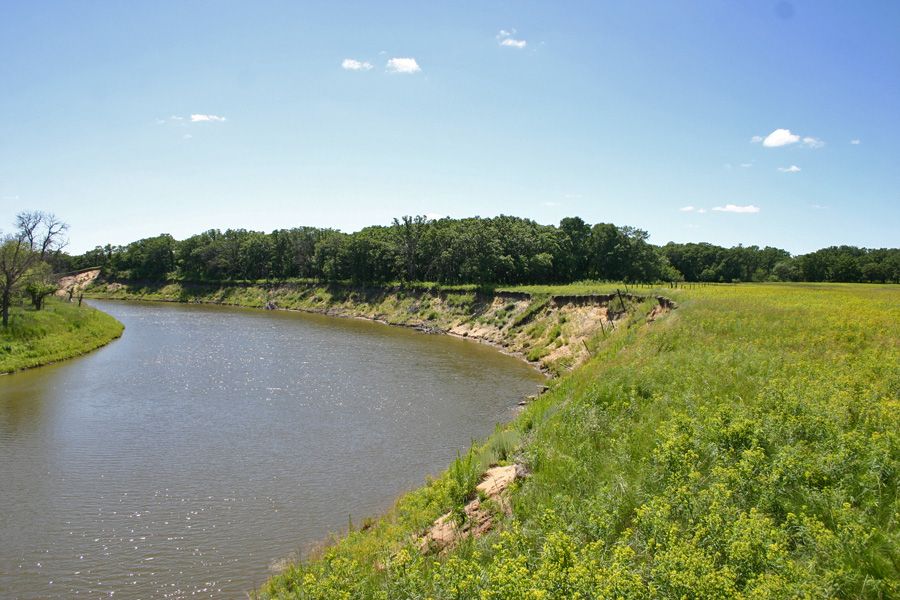
The Desjarlais site in 2016.
Page 20: The Turtle Mountain & Souris River Posts
| In
addition to the clusters of posts at
Souris Mouth and in the
Hartney-Lauder area, there were several other attempts to reach out to
suppliers. Lena House In the fall of 1801, John McKay of Brandon House sent Henry Lena with seven men and supplies to Turtle Mountain along with instructions to “cut off every independent” fur trader in that area. Lena House is one of two fur trading posts located near Turtle Mountain. It was close to the southeastern shore of Whitewater Lake and some distance east of Turtlehead Creek. It operated from about 1801 until 1802 but was not very successful in its aim of closing down rival trade in the area. The XY Company set up a trading post about a kilometre away, placing themselves directly on the path that the Assiniboine First Nations would take were they to cross Turtle Mountain to trade. In 1846, Governor Simpson of the HBC informed the Company head office in London that a new post was being established on Turtle Mountain. This fort seems to have operated from 1846 to 1855. Lena House wasn’t a big success. It did survive long enough, though, to provide the name for one of southwestern Manitoba's small hamlets. Although there is little left of Lena the village, it is also the name of an international port of entry south of Killarney. Sourisford Area A total of 18 posts grew and faded from the Souris River between present-day Souris, Manitoba and Minot, North Dakota. Almost all traces have been erased and few records remain, but we do know that an American Fur Company Trading Post was located near where North Antler Creek enters the Souris. There is also a record of a post near Melita operated by Peter Garrioch, established in 1843, and at least one other independent operation in the Melita – Napinka area. |
Page 21: The Metis Hunting Grounds
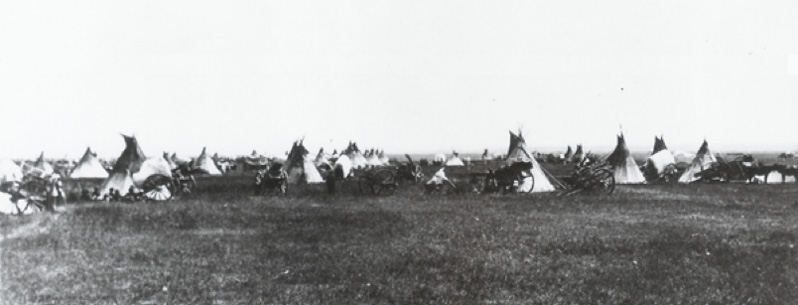
Metis Hunting Camp
| Beginning
around 1820, large hunting
expeditions from the Red River
Settlement set out twice a year to supply the settlers and the Hudson’s
Bay Company with pemmican and hides. The hunt was very important to the food supply of the HBC and the settlers at Red River (now known as Winnipeg). The hunt got bigger each year until about 1840, when 1,210 carts were used. The larger hunt took place in summer and a smaller one in autumn. Wintering Communities In some cases Metis hunting communities located on the plains in temporary villages. Some were only several families large, while others could have 1000 people. The villages were made up of roughly-built sturdy huts. It often took no longer than a day or two to construct such a hut with the aid of a single axe and a knife. A wintering community generally consisted of hunters, their families and a few fur traders. 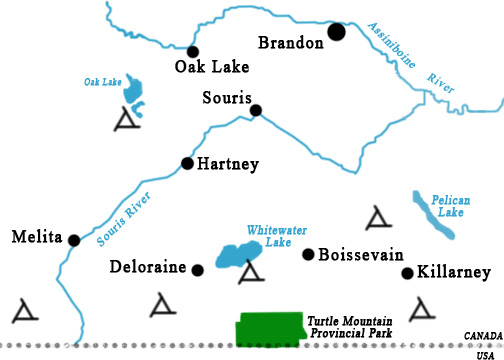 The general locations of the some of the wintering communities that existed in southwest Manitoba. Buildings were usually constructed in late fall in preparation for winter and abandoned in early spring. Sites of past communities were not generally returned to year after year because of changes in buffalo wintering ranges, and also due to the fact that rival First Nations would often burn the buildings to the ground as soon as they were unoccupied. As the bison disappeared in the late 1870s, wintering communities were not needed and most of them simply disappeared from the prairies. Some Métis hunters and their families did stay and become the first homesteaders in the region. |